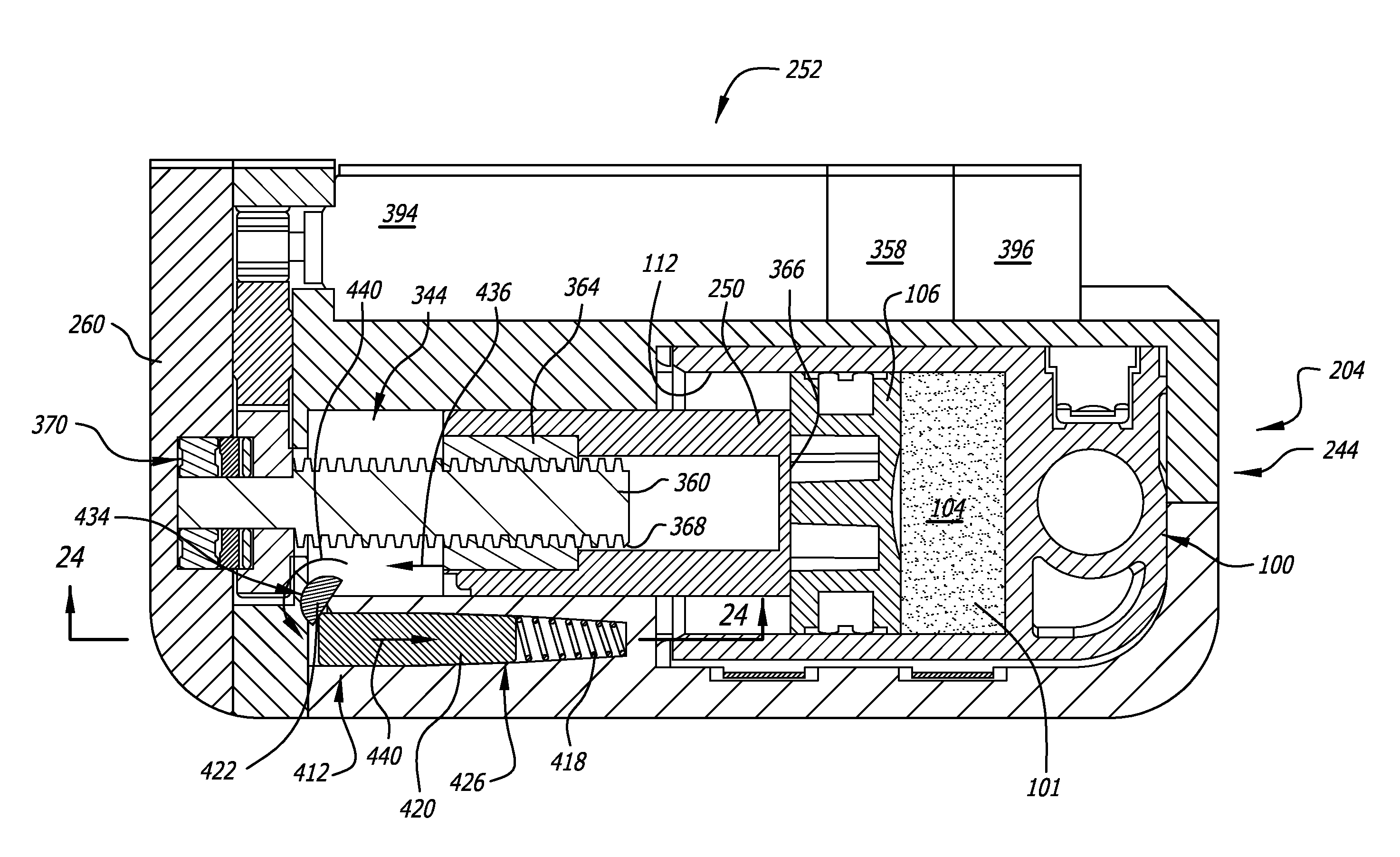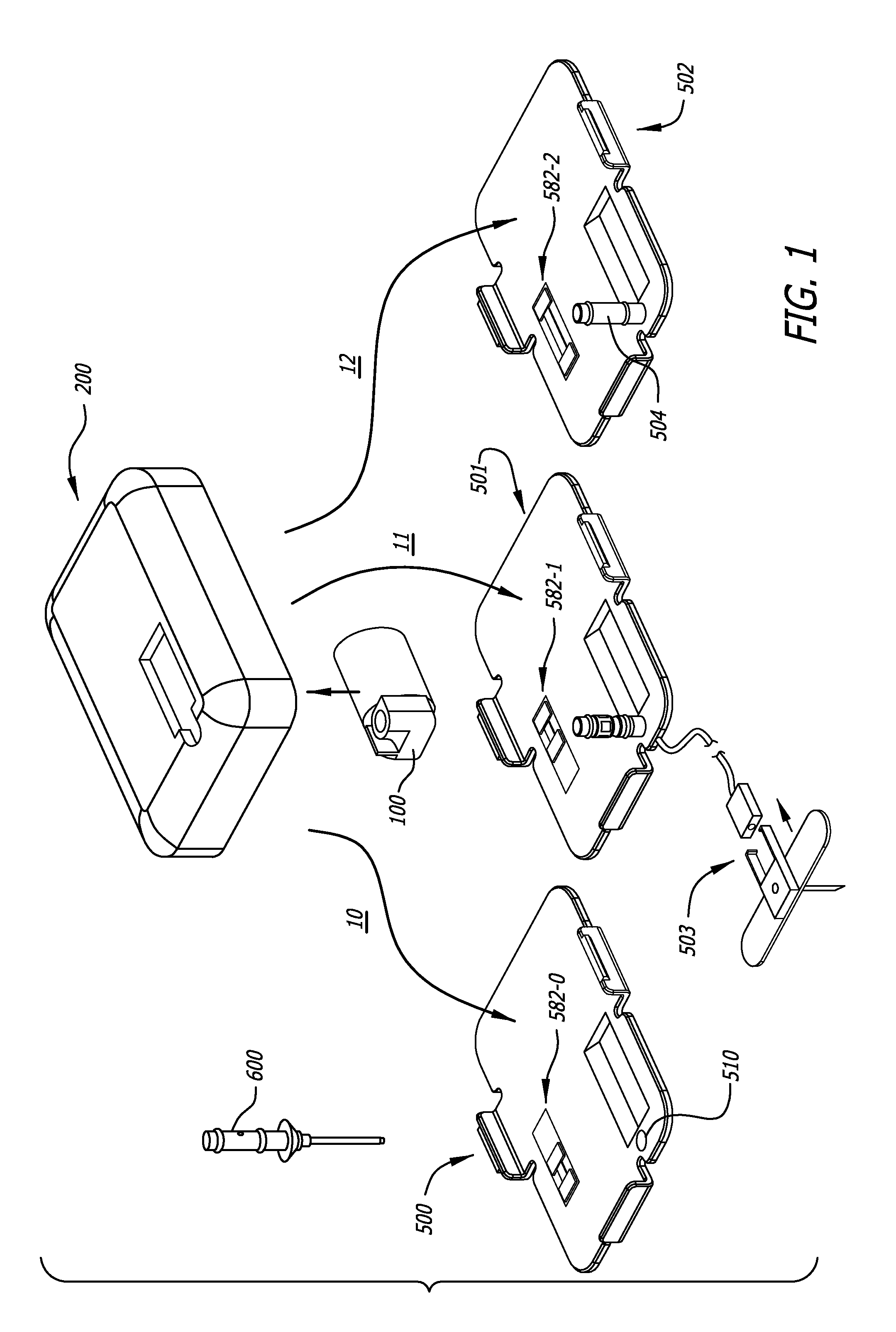Unfortunately, when the volume of the reservoir is reduced, all other things being equal, there is a corresponding reduction in convenience because the smaller reservoir requires more frequent refilling or replacement.
Using U-500
insulin, the missed volume for a 3 IUs alert is reduced to six μl due to the higher
insulin concentration, and conventional infusion pumps are not capable of this level of accuracy.
Another convenience related issue identified by the present inventors relates to the fact that a patient may desire to use a pocket pump in some instances and a patch pump in others.
In addition to the added expense, switching between two different infusion pumps may adversely effect the patient's medicament delivery
regimen.
For example, portions of the medicament delivery path from the reservoir to the cannula (or
infusion set tube) can become clogged or otherwise in need of repair.
Such repair may be inconvenient and costly in the context of many conventional infusion pumps because the pump mechanism (e.g., a
piston or
peristaltic pump) is part of the medicament delivery path.
The present systems obviate this unpleasant aspect of some conventional infusion pumps by removing the medicament flow path from the reusable portion of the
system.
By way of example, but not limitation, some users prefer to avoid
cartridge filling procedures because they are inconvenient and tend to involve needles.
In addition, the presence of 20 μl of air in the
cartridge results in the patient not receiving 10 IUs of U-500
insulin during the life of the
cartridge.
Such bubble
entrapment reduces the likelihood that bubbles will be dispensed and, accordingly, reduces the likelihood that medicament dispensing and
occlusion sensing will suffer bubble-related decreases in accuracy.
Overcompression is undesirable as the
resultant seal has a wide range of static / running forces, so compression is engineered to be within a predictable range.
In some instances, long term interaction between the medicament and the
pressure sensor diaphragm (e.g., diaphragm 134) during shipping and storage may be problematic.
The present inventors have determined that one issue associated with any patch pump is that it may be fully or partially dislodged from the patient's
skin (i.e., “falls off”) without the patient's knowledge.
Such full or partial dislodgement could bend the cannula or otherwise interfere with medicament delivery.
A linear
voltage regulator may be employed, although this may be an unnecessary drain on the battery.
The present inventors have determined that it can be difficult to keep the cannula fixed and erect in the wound, given that the
skin may be rough and non-planar and the
wound area may be soft, wet and flexible, and that the failure to keep the cannula fixed and erect in the wound may cause the cannula to bend and occlude.
However, strong
adhesive is more likely to irritate and even damage the skin.
Thus, a dispensing process based on an estimate / measurement of this distance at the time of manufacture may result in under delivery or over delivery in some circumstances.
While this level of fidelity may be adequate in the context of U-100 insulin, where 30 μl equates to 3 IUs of insulin, it would result in a much more problematic 15 IUs of missed delivery in the U-500 context.
Occlusions may also lead to other undesirable outcomes.
For example, continuing to drive the motor in the presence of an
occlusion may lead to cartridge leakage and / or damage to various aspects of the drive mechanism.
Briefly, when a controller cuts off power to a motor, the motor will continue to rotate, in a now uncontrolled state, due to its own
momentum and the
momentum of other rotating aspects of the drive mechanism.
Although one could simply
cut off power a few revolutions prior to the end of a delivery cycle, the precise number of “extra,” post
cut-off revolutions is difficult to accurately and consistently estimate.
As such, the simple act of turning the motor on and off, from
dose to
dose, can lead to under delivery and / or over delivery error due to the uncontrolled movement of the
plunger pusher.
It may be that, at the end of the remaining time, the user anticipates activity (e.g., sleeping, traveling, exercising, attending a social or business event) which would render cartridge replacement inconvenient or impossible.
Other alarm conditions may include an error associated with
pressure sensing hardware and delivery decision hardware.
 Login to View More
Login to View More  Login to View More
Login to View More 


